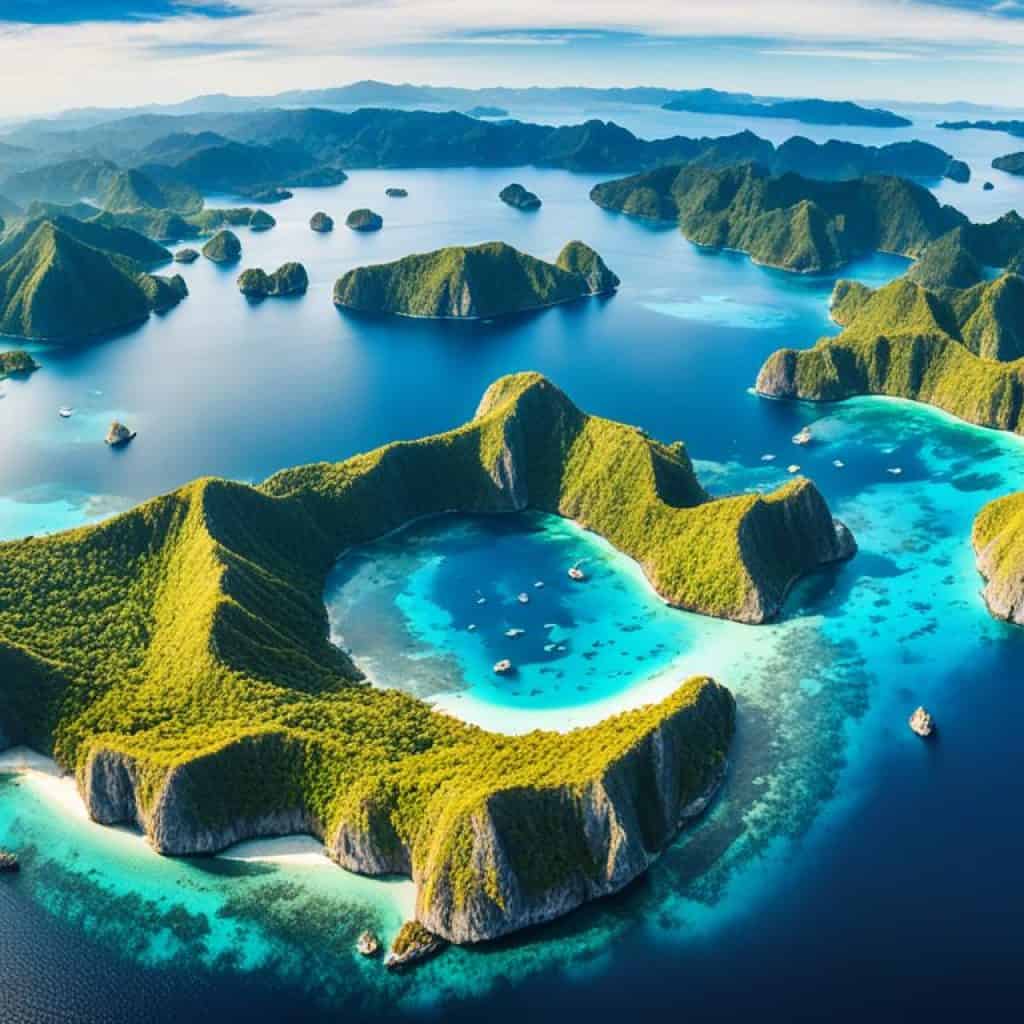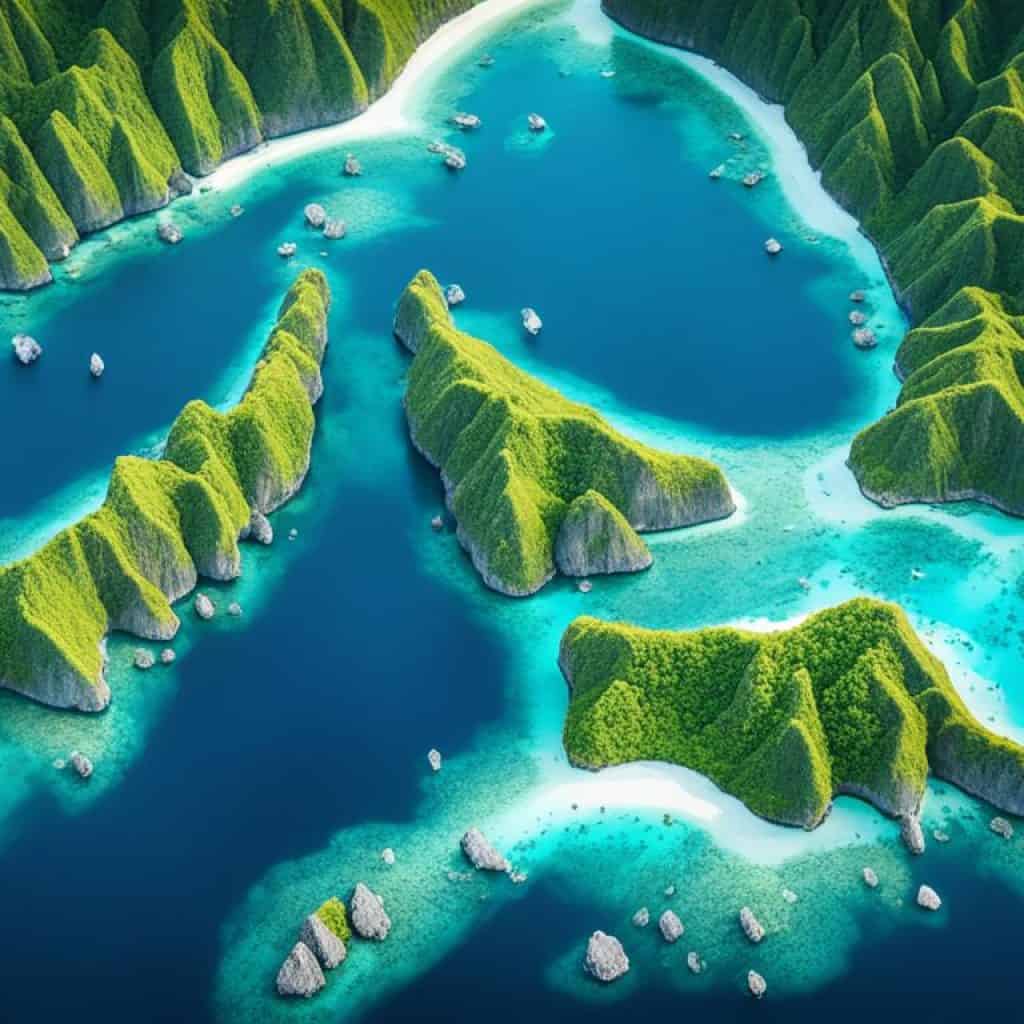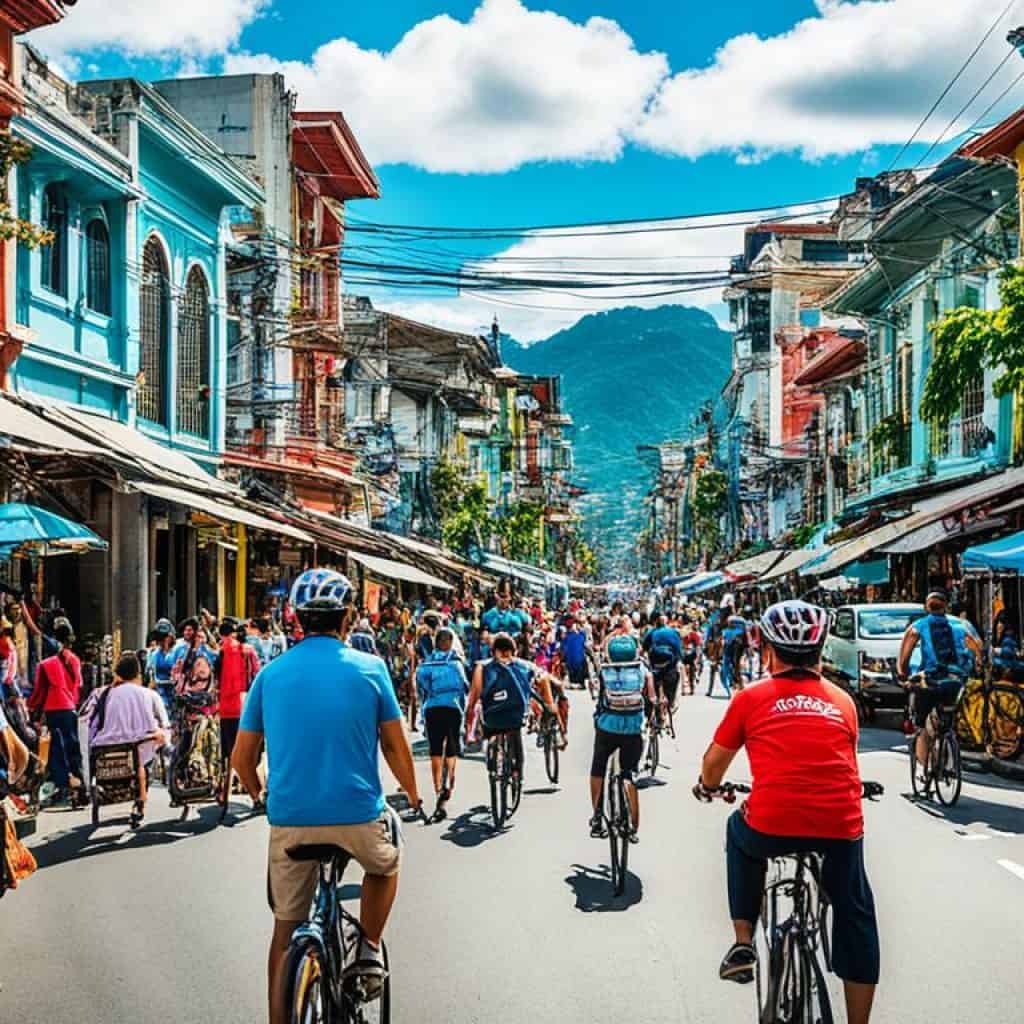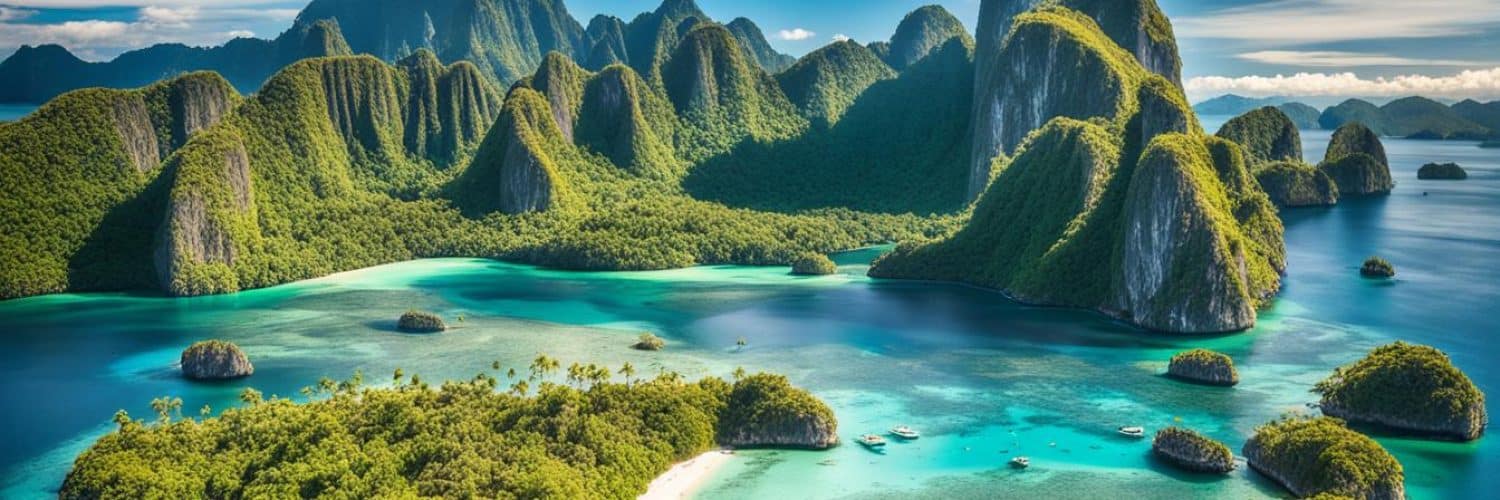Have you ever wondered about the vast and diverse national territory of the Philippines? What are its geographical boundaries, and how is the Philippine archipelago defined? Do you know the extent of the Philippine territorial waters and how they contribute to the country’s sovereignty? Join us on a journey as we delve into the mapping, sovereignty, and natural wonders that shape the National Territory of the Philippines.
Key Takeaways:
- The National Territory of the Philippines comprises the Philippine archipelago and other territories under Philippine sovereignty.
- The Philippine archipelago is made up of approximately 7,107 islands, each with its own unique landscapes.
- The territorial waters surrounding the Philippine archipelago play a crucial role in the country’s boundaries and sovereignty.
- The Philippines has faced territorial disputes with neighboring countries, such as China, over certain areas in the South China Sea.
- Exploring the National Territory of the Philippines reveals a rich tapestry of natural beauty, cultural heritage, and diverse topography.
Mapping the Philippines Territory
The Philippines is an archipelago consisting of approximately 7,107 islands. Located in Southeast Asia, between the South China Sea and the Philippine Sea, it is known for its stunning geographical boundaries. The major islands of the Philippines include Luzon, Visayas, and Mindanao. Luzon, the largest island, is situated in the northern part of the country, while Mindanao, the second-largest island, is found in the southern part.
The Philippine archipelago stretches approximately 1,850 kilometers from north to south and 1,000 kilometers from east to west, creating a vast and diverse territory. The land area of the Philippines is about 298,000 square kilometers, with an additional 2,000 square kilometers of water. This extensive area encompasses various regions with distinct topography, including plains, valleys, and mountains.
Exploring the Philippines’ rich and varied landscape is a fascinating journey that unveils breathtaking natural beauty at every turn.
| Island | Size |
|---|---|
| Luzon | 109,965 sq km |
| Visayas | 71,503 sq km |
| Mindanao | 104,530 sq km |
Highlights of the Philippines Territory:
- 7,107 islands forming the Philippine archipelago
- Luzon: the largest island in the northern part of the country
- Visayas: a group of islands centrally located in the Philippines
- Mindanao: the second-largest island in the southern part of the country
- Approximately 1,850 kilometers from north to south and 1,000 kilometers from east to west
- Total land area of about 298,000 square kilometers
- Diverse topography including plains, valleys, and mountains
“In the Philippines, you’ll discover a true paradise where every island has a story to tell and every corner reveals a breathtaking view. The mapping of its territory showcases the country’s magnificent natural wonders, inviting you to explore its diverse landscapes.”
Philippine Archipelago and Territorial Waters
The Philippine archipelago is a stunning collection of islands and waters that are encompassed within the national territory of the Philippines. This magnificent archipelago is defined by its vast expanse of natural beauty, including not only the islands themselves but also the surrounding waters and marine ecosystems.
According to the Philippine territory definition, the archipelago consists of the territorial sea, which extends 12 nautical miles from the baselines, as well as the seabed, subsoil, insular shelves, and other submarine areas. These territories are considered a vital part of the Philippine national territory, constituting the country’s territorial waters.
When exploring the archipelago, one experiences the breathtaking beauty and sheer diversity of the Philippine territorial waters, which consist of the waters around, between, and connecting the islands of the archipelago. These waters are essential to the country’s heritage and economy, providing a rich marine ecosystem and serving as a vital transportation route for trade and commerce.
The archipelagic doctrine, established by international law, is used to determine the boundaries of the Philippine archipelago and its territorial waters. This doctrine recognizes the unique geographic and legal status of archipelagos and considers their islands and waters as one cohesive unit. It further asserts that the archipelago and its territorial waters are integral parts of the national territory, providing the Philippines with complete sovereignty and control over these areas.
Now, let’s take a closer look at the Philippine archipelago and its remarkable territorial waters with a visual representation:

| Key Points | Details |
|---|---|
| Archipelago Definition | All the islands and waters embraced within the national territory of the Philippines |
| Territorial Sea | Boundary extends 12 nautical miles from the baselines |
| Seabed, Subsoil, Insular Shelves, and Submarine Areas | Included within the archipelago |
| Territorial Waters | Waters around, between, and connecting the islands of the archipelago |
| Archipelagic Doctrine | Used to determine boundaries and establish sovereignty over the archipelago and its territorial waters |
In conclusion, the Philippine archipelago and its territorial waters are not only a geographic marvel but also a testament to the country’s sovereignty and rich natural heritage. As we continue to explore the national territory of the Philippines, we are awe-struck by the sheer beauty and importance of these magnificent islands and waters.
Philippine Sovereignty and Jurisdiction
The Philippines exercises sovereignty and jurisdiction over its national territory, including the Philippine archipelago and other territories within its boundaries. The country has the right to govern and control these areas, including the terrestrial, fluvial, and aerial domains, as well as the territorial sea, seabed, subsoil, insular shelves, and other submarine areas.
The Philippines exercises sovereignty and jurisdiction over its national territory.
However, the Philippines has faced territorial disputes with neighboring countries, such as China, over certain areas in the South China Sea. These disputes are still ongoing, and the Philippines continues to assert its sovereignty and rights over its territories.
| Philippine Sovereignty and Jurisdiction | Philippines Territorial Dispute |
|---|---|
| Philippines exercises sovereignty and jurisdiction over its national territory | Philippines faces territorial disputes, particularly with China, in the South China Sea |
| Includes terrestrial, fluvial, and aerial domains, as well as territorial sea, seabed, subsoil, insular shelves, and other submarine areas | The disputes involve claims over certain areas in the South China Sea |
| The Philippines asserts its sovereignty and rights over its territories | The disputes are ongoing, with the Philippines standing firm in asserting its rights |
Philippine Sovereignty and Territorial Disputes
Philippine sovereignty is exercised over the entire national territory, including the Philippine archipelago and other territories. The country has the authority to govern and control these areas, ensuring its rights and interests are protected. However, disputes have arisen with neighboring countries, particularly China, over certain areas in the South China Sea. The Philippines remains committed to asserting its sovereignty and pursuing diplomatic solutions to these territorial disputes.
- The Philippines exercises sovereignty and jurisdiction over its national territory
- Territories include the Philippine archipelago, terrestrial, fluvial, and aerial domains, as well as territorial sea, seabed, subsoil, insular shelves, and other submarine areas
- Territorial disputes have occurred with China in the South China Sea
- The Philippines asserts its sovereignty and rights over its territories
The Philippines recognizes the importance of protecting its national sovereignty and continues negotiations, diplomatic efforts, and legal avenues to resolve territorial disputes and promote peace and stability in the region.
Philippine Land Area and Geographical Boundaries
The land area of the Philippines is vast, covering approximately 298,000 square kilometers. Positioned in Southeast Asia, the country’s geographical boundaries are defined by the surrounding waters of the archipelago. Let’s take a closer look at the specifics of the Philippines’ land area and its geographical boundaries.
| Direction | Bordering Body of Water | Adjacent Country |
|---|---|---|
| North | Bashi Channel | Taiwan |
| East | Pacific Ocean | N/A |
| South | Celebes Sea | Malaysia and Indonesia |
| West | South China Sea | Vietnam and China |
The Philippines does not share any land boundaries with other countries, as it is a country composed entirely of islands. Its neighboring countries are Taiwan to the north, Malaysia and Indonesia to the south, Vietnam to the west, and China to the northwest.
With its strategic location and diverse geographical features, the Philippines offers a unique and enchanting environment. The surrounding waters and breathtaking landscapes contribute to both the beauty and the challenges that come with governing and protecting the nation’s territory.

Immerse yourself in the rich beauty and splendor of the Philippines’ land area and geographical boundaries. Discover the country’s stunning landscapes and natural wonders as you explore its diverse archipelago.
Philippine Climate and Weather
The Philippines experiences a tropical climate, characterized by two distinct seasons: the rainy season and the dry season. Understanding the climate and weather patterns of the country is crucial for travelers and locals alike.
Tropical Climate: Rainy Season and Dry Season
The Philippines’ rainy season usually occurs from June to November, coinciding with the southwest monsoon. During this period, the country receives heavy rainfall, making it important to plan outdoor activities accordingly. Hiking trips, beach excursions, and other outdoor adventures may be best enjoyed during the drier months to avoid unexpected downpours.
The dry season, also known as the summer season, is experienced from December to February. This is the time when the weather is generally more pleasant and conducive for various outdoor activities. It’s the perfect season for beach vacations, island hopping, and exploring the country’s natural wonders.
Average Temperature and Humidity
The average temperature in the Philippines varies throughout the year. In January, the coolest month, the average temperature is around 25.5°C (77.9°F). In May, the average temperature rises to 28.3°C (82.9°F). It’s important to note that humidity levels remain high throughout the year, ranging from 71% in March to 85% in September.
Typhoon Season and Cooler Months
The Philippines is susceptible to typhoons, especially from July to October. Travelers should stay informed about weather updates and take necessary precautions during this period. On the other hand, the months from November to February are considered the cooler season. The cooler temperatures make this time of year ideal for exploring urban destinations and immersing oneself in the rich cultural heritage of the Philippines.
Average Monthly Temperature in the Philippines
| Month | Average Temperature (°C) |
|---|---|
| January | 25.5 |
| February | 25.9 |
| March | 26.6 |
| April | 27.3 |
| May | 28.3 |
| June | 28.0 |
| July | 27.2 |
| August | 27.0 |
| September | 27.0 |
| October | 26.9 |
| November | 26.4 |
| December | 25.6 |
Source: Philippine Atmospheric, Geophysical and Astronomical Services Administration (PAGASA)
Regardless of the season, the Philippines offers a wealth of natural beauty and cultural experiences to explore. From pristine beaches to vibrant cities, there’s always something to discover in this tropical paradise.
Philippine Topography
The topography of the Philippines is characterized by a diverse landscape that includes plains, valleys, and mountains. The country’s terrain provides a rich resource base and contributes to its thriving agricultural and tourism sectors.
Agricultural lands can be found throughout the Philippine archipelago, with each province cultivating its own crops and livestock. This agricultural diversity is made possible by the varied topography that accommodates different farming practices and terrains.
In the northern part of the country, the coast of Ilocos lies to the west, while the Central Cordillera mountain range dominates the eastern side. The Central Cordillera is home to majestic peaks and lush valleys, offering breathtaking landscapes and opportunities for outdoor activities.
Between the Central Cordillera and the Sierra Madre mountain range lies the Cagayan Valley. Known as the “Rice Granary of the Philippines,” this fertile plain contributes significantly to the country’s rice production.
“The diverse topography of the Philippines provides a picturesque backdrop to its vibrant agricultural and tourism industries. From the fertile plains to the majestic mountains, the country’s natural beauty is truly a sight to behold.”
To fully appreciate the extent of the Philippines’ topographical diversity, here’s a comparative overview of its major geographical regions:
| Region | Description |
|---|---|
| Ilocos Region | Located in the northwestern part of Luzon, this region features coastal areas, valleys, and low plains suitable for agriculture. |
| Central Cordillera | Stretching across Luzon, this mountain range includes several of the country’s highest peaks and picturesque valleys. |
| Cagayan Valley | Known as the “Rice Granary of the Philippines,” this region boasts fertile plains perfect for rice cultivation. |
| Sierra Madre | Running along the eastern coast of Luzon, this mountain range offers scenic views and is home to diverse flora and fauna. |
| Visayas Region | Comprising several islands, including Panay, Negros, Cebu, and Bohol, this region showcases a mix of plains, mountains, and coastal areas. |
| Mindanao | The southernmost major island of the Philippines, Mindanao features vast agricultural lands, towering peaks, and picturesque beaches. |
The Philippines’ topography not only adds to its natural beauty but also provides opportunities for various economic activities, such as agriculture, tourism, and outdoor recreation. The plains, valleys, and mountains contribute to the country’s overall charm and allure, attracting visitors from around the world.
Philippine Tourism and Natural Beauty
The Philippines is a destination renowned for its breathtaking natural beauty, making it a favorite among tourists. With its pristine beaches and stunning coastal landscapes, the country offers a paradise escape for beach lovers.
One of the top attractions in the Philippines is its magnificent beaches, known for their powdery white sands, crystal-clear waters, and vibrant marine life. Whether you’re seeking a serene getaway or thrill-seeking adventures, the Philippines has something for everyone. Two popular beach destinations are Panglao Island in Bohol and El Nido in Palawan.
Panglao Island in Bohol showcases a combination of picturesque beaches and diverse marine ecosystems. Visitors can enjoy swimming, snorkeling, and diving in its warm turquoise waters. El Nido in Palawan, on the other hand, offers stunning limestone formations, hidden lagoons, and secret beaches, creating an enchanting backdrop for exploration and relaxation.
Aside from its magnificent beaches, the Philippines is also home to more than 30 national parks, providing opportunities for nature enthusiasts and adventure seekers. These national parks offer a wide range of activities such as hiking, wildlife spotting, and river cruising, allowing visitors to fully immerse themselves in the country’s rich biodiversity.
Here are some notable national parks in the Philippines:
| National Park | Location | Highlights |
|---|---|---|
| Calauit Safari Park | Busuanga, Palawan | Home to various wildlife species, including giraffes, zebras, and endangered Philippine animals |
| Puerto Princesa Subterranean River National Park | Palawan | Features a navigable underground river and a diverse ecosystem |
| Mounts Iglit-Baco National Park | Mindoro | Serves as a sanctuary for the endangered Tamaraw, a small water buffalo species |
Exploring these national parks allows visitors to appreciate the natural wonders and rich wildlife that the Philippines has to offer. It’s a great way to connect with nature and create lasting memories.
Whether you’re seeking a relaxing beach getaway or an adventurous expedition through national parks, the Philippines offers a wealth of natural beauty and endless opportunities for exploration and adventure.
Cities and Cultural Heritage in the Philippines
The Philippines is a country rich in cultural heritage, with vibrant cities that offer unique attractions and experiences. From historical sites to diverse cuisines, these cities showcase the country’s rich history and cultural diversity.
Manila
The capital city of the Philippines, Manila, is a bustling metropolis that seamlessly combines the old and the new. Here, visitors can explore historical landmarks such as Intramuros, the walled city built during the Spanish colonial period. The city is also home to numerous museums that showcase the country’s art, history, and culture. Shopping enthusiasts can indulge in the modern malls and street markets that offer a wide variety of products. Manila’s culinary scene is diverse, with local delicacies and international cuisines to satisfy any palate.
Davao City
Davao City, known as the largest city by land area, is a major hub in the southern part of the Philippines. Apart from its urban landscape, the city is renowned for its natural attractions. Mount Apo, the highest peak in the Philippines, offers breathtaking views and opportunities for hiking and mountain climbing. The Philippine Eagle Center is another must-visit destination, where visitors can learn about the conservation efforts for the country’s national bird, the Philippine Eagle.
Cebu City
Cebu City, one of the oldest cities in the Philippines, is a vibrant destination that blends urban living with island experiences. The city is known for its historical sites, such as the Magellan’s Cross, which holds significance in the country’s colonial history. Visitors can also explore the Basilica Minore del Santo Niño, a well-known religious landmark. Cebu City offers a dynamic nightlife scene, with numerous bars, clubs, and restaurants. For those seeking beach getaways, the nearby islands of Mactan and Bantayan offer pristine beaches and crystal-clear waters.
Vigan
Vigan, a UNESCO World Heritage site, is known for its well-preserved Spanish colonial architecture and cobblestone streets. Walking through the historic district of Calle Crisologo feels like stepping back in time, with ancestral houses and colonial-era structures. Visitors can take a calesa, a traditional horse-drawn carriage, to explore the city’s landmarks, churches, and museums. Vigan is also famous for its local delicacies, such as empanada and bagnet, which are must-try dishes for food enthusiasts.
These cities in the Philippines offer a glimpse into the rich cultural heritage and history of the country. From historical landmarks to local delicacies, each city has its own distinct charm and attractions. Exploring these cities is an opportunity to immerse oneself in the vibrant Filipino culture and create lasting memories.

Wildlife and Conservation in the Philippines
The Philippines is a treasure trove of diverse wildlife, making it a haven for nature enthusiasts and conservationists. The country’s commitment to protecting and preserving its natural resources is commendable. One of the unique wildlife experiences in the Philippines can be found on Calauit Island, where visitors have the opportunity to swim with dugongs, fascinating marine mammals closely related to manatees.
To raise awareness about the importance of wildlife conservation, conservation tours and educational programs are available. These initiatives aim to empower both locals and tourists to actively participate in protecting and preserving the Philippines’ rich biodiversity.
“Conservation is the key to safeguarding the future of our wildlife. By fostering a sense of stewardship among individuals and communities, we can ensure the survival of these magnificent creatures for generations to come.” – Dr. Maria Santos, Marine Biologist
The natural wonders of the Philippines showcase the harmony between human activity and nature. The famous Chocolate Hills in Bohol, with their unique geological formations, serve as a reminder of how the Earth’s natural processes can create awe-inspiring landscapes. Meanwhile, the Ifugao Rice Terraces, a UNESCO World Heritage site, demonstrate the indigenous people’s sustainable agricultural practices that have been passed down for generations.
Efforts are continually made to preserve and promote these natural attractions, allowing visitors to appreciate and marvel at the country’s unique landscapes. By supporting sustainable tourism practices and conservation initiatives, individuals can contribute to the long-term preservation of the Philippines’ wildlife and natural beauty.
Travel Tips and Requirements for Visiting the Philippines
Planning a trip to the Philippines? Here are some essential travel tips and requirements to ensure a smooth and enjoyable experience in this beautiful country.
Travel Documents and Vaccination
When traveling to the Philippines from the United States, make sure you have a valid passport. The good news is that U.S. citizens do not need a visa for stays of up to 30 days. However, if you plan to stay longer, you’ll need to apply for a visa extension. It’s always a good idea to check the latest travel requirements with the Philippine Embassy or Consulate in your country.
Moreover, the World Health Organization recommends certain vaccinations before traveling to the Philippines. Some of the vaccinations to consider include hepatitis A, hepatitis B, typhoid, and influenza. Make sure you consult with your healthcare provider well in advance to ensure you are up to date with your vaccinations and to discuss any other health-related concerns.
Best Time to Visit the Philippines
The Philippines has a tropical climate, making it important to plan your trip based on the weather conditions. The best time to visit the Philippines is during the dry season, which typically runs from December to April. During this period, the weather is generally more pleasant, with plenty of sunshine and lower chances of rain. It’s the perfect time to explore the beautiful beaches, go diving, or visit the stunning natural attractions.
However, it’s essential to note that the Philippines is prone to typhoons from July to October. If you plan to travel during this period, be sure to monitor weather updates and follow any advisories issued by local authorities.
Eco-Friendly Practices
Traveling responsibly is crucial for preserving the beauty of the Philippines and minimizing environmental impact. Consider adopting eco-friendly practices during your visit, such as using reusable bottles and bags to reduce plastic waste. Furthermore, be mindful of your surroundings and follow designated trails and guidelines when exploring national parks and protected areas.
“Traveling is not just about visiting a place; it’s also about leaving a positive impact and preserving its natural beauty for future generations.”
Summary of Travel Tips and Requirements
| Travel Requirements | Best Time to Visit | Eco-Friendly Practices |
|---|---|---|
| Valid passport; no visa required for U.S. citizens | Dry season from December to April | Use reusable bottles and bags |
| Check latest travel requirements with the Philippine Embassy | Monitor typhoon season from July to October | Follow designated trails and guidelines |
| Consult healthcare provider for recommended vaccinations |
By keeping these travel tips in mind, you can enjoy a memorable and responsible trip to the Philippines. From exploring pristine beaches to immersing yourself in the rich culture and heritage, the Philippines has something for every traveler.
Conclusion
The National Territory of the Philippines comprises the picturesque Philippine archipelago, with its abundant natural wonders and diverse topography. Spanning from plains to mountains, the country offers a tropical climate that sets the stage for unforgettable adventures. Whether it’s exploring stunning beaches or immersing oneself in national parks, the Philippines has something for every traveler.
While territorial disputes pose challenges, the Philippines remains resolute in asserting its sovereignty and safeguarding its valuable resources. The country’s commitment to preserving its rich cultural heritage and natural beauty is evident in its thriving tourism industry. Visitors can immerse themselves in the vibrant local culture, savor delectable cuisine, and discover the wonders that define the National Territory of the Philippines.
With its vast land area, well-defined geographical boundaries, and a welcoming climate, the Philippines beckons travelers to embark on an unforgettable journey. From the breathtaking landscapes to the warm hospitality of its people, the country’s allure is undeniable. Explore the Philippines, uncover its hidden treasures, and create lasting memories in this enchanting destination.


















Add comment